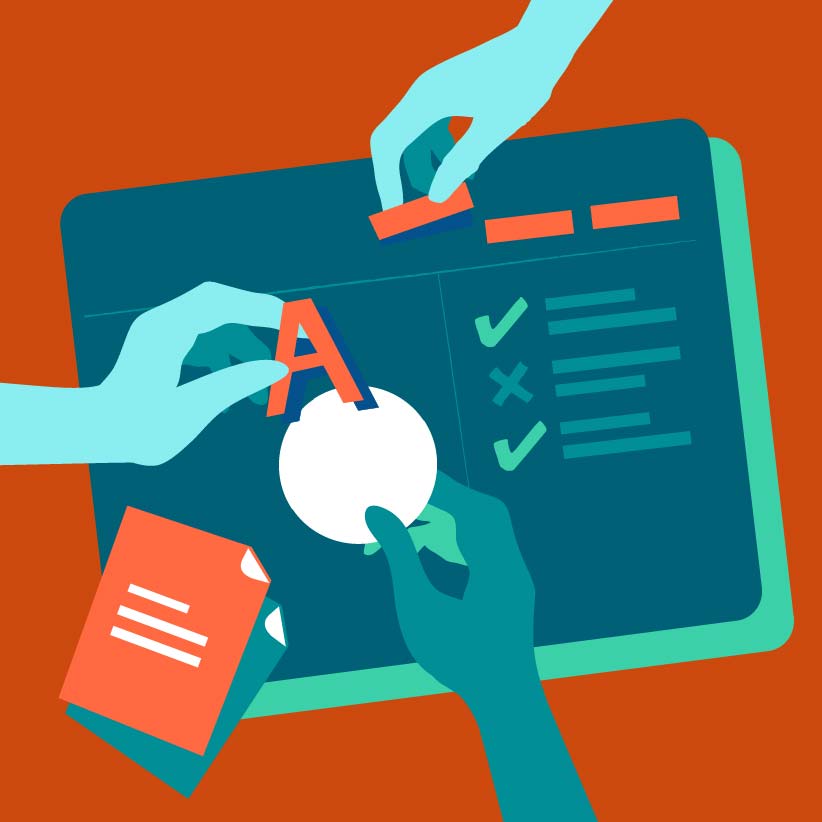Monograms: Tips for Designing Logos with Initials
What monograms are, their purpose, and how to create a great custom monogram.
In this guide you will find:
What is a monogram?
A monogram is a type of graphic symbol consisting of a combination of letters to create a unique and distinctive image for identification purposes. It is an image or design created from the stylization and combination of letters, usually the initials of a name or company.
Monograms are a widely used form of design due to their ability to create a unique and easily recognizable image. There are at least two ways to create monograms: simple letter monograms, which use only one or two letters; and interlocking letter monograms, which are more complex, as the letters overlap in such a way that both can be perceived with relative clarity.
Monograms have been used since the time of Ancient Greece and Rome, where they were used to mark ownership and belonging of goods. During the Middle Ages, monograms were used on seals and manuscripts, and later became popular in fashion and jewelry. Today, monograms are used as identifying marks for all types of organizations.
What are monograms for?
In a world full of instantly recognizable logos and brands, it's easy to underestimate the power of a monogram. A monogram, also known as interlocking initials, is a graphic representation of the letters of a name or company. Although it may seem like a simple ornament, a monogram has a deeper purpose and can be a powerful tool in the field of design and visual identity.
A monogram is an effective way to create a unique and memorable identity for a brand, company, or individual. By combining the initials of a name, a custom symbol is created that can be used in various contexts. This monogram can be applied to products, packaging, business cards, websites, and social media profiles, allowing for quick and easy identification. When customers see a brand's monogram, they immediately link it with the values and products associated with it, thus creating an emotional connection and instant recognition.
A monogram is not only useful from a functional standpoint, but it can also be a powerful aesthetic element. Many brands and designers use monograms to add a touch of sophistication and elegance to their products and designs. A well-designed monogram can convey a sense of exclusivity and refinement, which is particularly relevant in sectors such as fashion, jewelry, and high-end goods. By creatively and uniquely combining letters, striking designs can be achieved that captivate the viewer's attention.
In an increasingly visual world full of stimuli, simplicity is key. Monograms allow a name or brand to be synthesized into a compact and easily recognizable design. This is especially useful in spaces where space is limited, such as clothing labels, small packaging, or digital avatars. By eliminating unnecessary elements and focusing on the initials, a visually appealing and versatile mark is created that can adapt to different formats and sizes without losing its essence.
A monogram can also be a way to personalize objects and products. From leather goods and jewelry to clothing and stationery, adding a monogram creates a sense of exclusivity and unique ownership. Interlocking initials can turn a common product into something special and personalized, which is appealing for both the consumer and for personalized gifts. Additionally, a monogram allows for easy identification in case of loss or theft, as the unique design makes it easily recognizable as someone's property.
What is the history of monograms?
Monograms are an art form that has endured throughout history, adorning objects and adding a personal touch to various items. They have a rich history dating back to ancient times. In this article, we will explore the fascinating history of monograms and their evolution over the centuries.
The earliest traces of monograms date back to ancient Greece and Rome, where coins and jewelry were adorned with intertwined symbols representing rulers and important figures. These monograms were considered marks of prestige and status, and were used as a form of identification and recognition.
During the Middle Ages, monograms took on a more personal meaning and became heraldic symbols. Noble families and knights used monograms as part of their coats of arms and personal seals. These monograms were elaborately designed and represented the genealogy and social standing of their bearers.
During the Renaissance, monograms reached new levels of sophistication and became a form of artistic expression. Monarchs and royal families adopted elaborate and ornate monograms, which were used to decorate jewelry, furniture, tapestries, and other luxury items. These royal monograms became symbols of power and reaffirmed the status of royalty.
As history progressed, monograms became more accessible and popular among the middle class and individuals. During the 18th and 19th centuries, monograms were used to personalize everyday objects, such as dinnerware, linens, cutlery, and clothing. These monograms were simpler and more elegant, usually representing the owner's initials.
Today, monograms continue to be an effective way to add a personal touch to various objects. From clothing and accessories to stationery and home goods, monograms allow people to stand out and express their unique style. Furthermore, companies and brands use monograms as part of their visual identity, creating distinctive logos that quickly identify them.
How to create monograms?
Here are some key tips for creating impactful and personalized monograms:
1. Research and plan
Before diving into the design process, research and plan properly. Identify the purpose and context of the monogram. Will you use it for your brand? Is it for a special occasion? Understanding the monogram's objective will help you make informed decisions during the design process.
2. Choose the right initials
The initials are the heart of a monogram, so choose the right letters carefully. If it's for a brand, use the company's or name's initials. For personal occasions, like weddings, consider combining the initials of the spouses' names. Experiment with different fonts and styles to find the perfect combination.
3. Explore different letter styles
The choice of font and letter style is crucial for designing a distinctive monogram. There is a wide variety of options, from classic and elegant typefaces to modern and bold fonts. Research different styles and choose those that align with the personality and tone you want to convey.
4. Balance legibility and aesthetics
Although aesthetics are important, the monogram's legibility must also be considered. Ensure the letters are easily identifiable and intertwine harmoniously. Avoid overly complicated combinations that could hinder readability. A successful monogram strikes the perfect balance between being visually appealing and legible.
5. Experiment with composition and design
Play with different compositions and layouts to find the style you like best. You can try different letter placements, orientations, negative spaces, and additional decorative elements. Remember that simplicity can be just as impactful, so don't be afraid to experiment with different approaches.
6. Consider versatility and adaptability
A good monogram should be versatile and adaptable to different formats and sizes. Make sure it works well in both large and small versions, whether printed on paper, engraved on objects, or used in digital media. A monogram that can be easily adapted without losing its essence ensures its effective use in various applications.
7. Test and request feedback
Once you have designed your monogram, test it in different contexts and ask for others' opinions. See how it looks on different backgrounds and materials. Ask for feedback from friends, colleagues, or design experts to get different perspectives and improve your creation.

Dealing with the client, budgeting and planning the stages of brand creation


